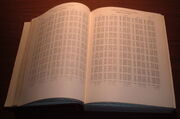Assessment |
Biopsychology |
Comparative |
Cognitive |
Developmental |
Language |
Individual differences |
Personality |
Philosophy |
Social |
Methods |
Statistics |
Clinical |
Educational |
Industrial |
Professional items |
World psychology |
Statistics: Scientific method · Research methods · Experimental design · Undergraduate statistics courses · Statistical tests · Game theory · Decision theory
Before calculators were cheap and plentiful, people would use mathematical tables —lists of numbers showing the results of calculation with varying arguments— to simplify and drastically speed up computation. Most common are tables of multiplication, which most people know from their early math classes:
| × | 1 | 2 | 3 | 4 | 5 | 6 | 7 | 8 | 9 | 10 | 11 | 12 |
| 1 | 1 | 2 | 3 | 4 | 5 | 6 | 7 | 8 | 9 | 10 | 11 | 12 |
| 2 | ..... | 4 | 6 | 8 | 10 | 12 | 14 | 16 | 18 | 20 | 22 | 24 |
| 3 | ..... | ..... | 9 | 12 | 15 | 18 | 21 | 24 | 27 | 30 | 33 | 36 |
| 4 | ..... | ..... | ..... | 16 | 20 | 24 | 28 | 32 | 36 | 40 | 44 | 48 |
| 5 | ..... | ..... | ..... | ..... | 25 | 30 | 35 | 40 | 45 | 50 | 55 | 60 |
| 6 | ..... | ..... | ..... | ..... | ..... | 36 | 42 | 48 | 54 | 60 | 66 | 72 |
| 7 | ..... | ..... | ..... | ..... | ..... | ..... | 49 | 56 | 63 | 70 | 77 | 84 |
| 8 | ..... | ..... | ..... | ..... | ..... | ..... | ..... | 64 | 72 | 80 | 88 | 96 |
| 9 | ..... | ..... | ..... | ..... | ..... | ..... | ..... | ..... | 81 | 90 | 99 | 108 |
| 10 | ..... | ..... | ..... | ..... | ..... | ..... | ..... | ..... | ..... | 100 | 110 | 120 |
| 11 | ..... | ..... | ..... | ..... | ..... | ..... | ..... | ..... | ..... | ..... | 121 | 132 |
| 12 | ..... | ..... | ..... | ..... | ..... | ..... | ..... | ..... | ..... | ..... | ..... | 144 |
To find 7×8, you'd look in the left column to seven, then across the "seven-line" to eight. The easily found answer is 56. To find 9×3, you'd swap the factors and find the equal product 3×9 (27) by the same technique.
History and use[]

Part of a table of common logarithms from Abramowitz and Stegun.
Tables of trigonometric functions were first known to be made by Hipparchus. Tables of common logarithms and antilogarithms were used to do rapid multiplications, divisions, and exponentiations, including the extraction of nth roots. Tables of special functions are still used. For example, the use of tables of values of the cumulative distribution function of the normal distribution remains commonplace today, especially in schools.
Mechanical special-purpose computers known as difference engines were proposed in the 19th century to tabulate polynomial approximations of logarithmic functions – i.e. to compute large logarithmic tables. This was motivated mainly by errors in the logarithmic tables made by the human 'computers' of the time. Early digital computers were developed during World War II in part to produce specialized mathematical tables for aiming artillery. From 1972 onwards, with the launch and growing use of scientific calculators, most mathematical tables went out of use.
Creating tables is a common code optimization technique, and works as well for computers as humans. In computers, use of such tables is done in order to speed up calculations in those cases where a table lookup is faster than the corresponding calculations (particularly if the computer in question doesn't have a hardware implementation of the calculations). In essence, one trades computing speed for the computer memory space required to store the tables.
See also[]
- Abramowitz and Stegun Handbook of Mathematical Functions
- Jurij Vega
- Matrix
- Random number table
- Truth table
External links[]
- Mathematical Table Generator -- generates addition, subtraction, multiplication, division, exponentiation, and trigonometric tables using JavaScript.
de:Einmaleins
| This page uses Creative Commons Licensed content from Wikipedia (view authors). |